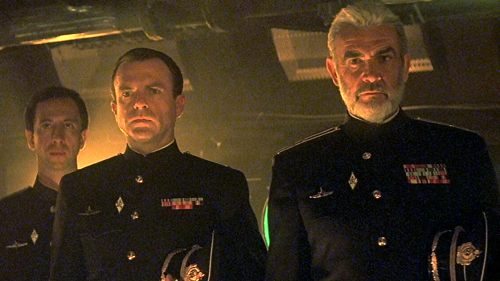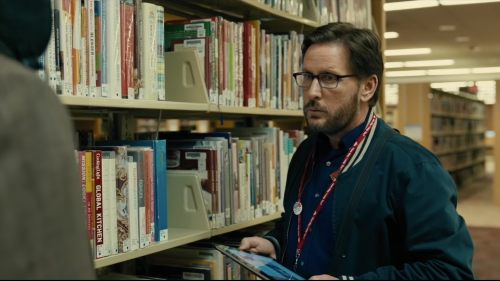Next Time, You Get To Be On Top: The Progressive Sexual Politics Of THE SHADOW
During a casual rewatch of the 1994 Alec Baldwin superhero flop THE SHADOW, I found myself gasping, legitimately dumbfounded by a throwaway one-liner mid-way through the film. The Shadow is fighting a nameless minion of the villain Shiwan Khan. They tumble out the window of a New York skyscraper. The Shadow is able to get the upper hand on the goon, sending him crashing down into a large sculpture jutting out of the side of the building. For no reason at all, The Shadow says to this presumably dead man, “Next time, you get to be on top.”
The non sequitur, double-entendre joke falls flatter than the bad guy The Shadow has just killed in combat. The implications of the comment are very obviously sexual. It’s a totally unmotivated, confusing line that seems like it’s only in there to get a laugh that never comes.
The more I pondered this bizarre choice throughout the rest of the movie, the more the intent became clear. The line is a statement of intent, that THE SHADOW is a thinly veiled allegory for male sexuality, a subversive comic epic about secrets, regrets, and identity.
+++
Superhero fiction is partially based on wish fulfillment. A significant reason why human beings find these stories appealing is that they represent a variety of discrete power fantasies: strength, invincibility, the chance to right moral wrongs. Superman can fly. Batman is rich. Captain America is righteous. The X-Men are persecuted minorities in the ascendant. The comic book characters that stick around the zeitgeist do so because they dramatize some subconscious desire within people.
Many of these power fantasies are traditionally associated with masculinity. Traditional manhood requires strength, wealth, physical fitness, and good looks. Superheroes like the Incredible Hulk, Beast, and The Thing are, on the surface, tragic figures. They’re “grotesque” or monstrous abominations of science that are harder to love in the normal sense. Romance with characters like that is almost always tortured, but even that is a form of wish fulfillment. Being so virtuous, good-hearted, and “beautiful on the inside” is itself an archetype for the reader to project their fantasies onto.
Consider, then, the superpower of The Shadow. Wealthy social butterfly Lamont Cranston can “cloud men’s minds,” as the mythology puts it. In other words, he can hypnotize people and read their thoughts. Also, he can make himself ostensibly invisible thanks to mental manipulation of his enemies. Doesn’t really grab you, does it? He’s basically a high-functioning magician with a penchant for accessorizing his wardrobe. Seriously, this guy has it all: a cape, a hat, an ascot, suspenders, gloves, a glowing ring, and two gleaming silver pistols. Seeing such a person in real life might not cause you to react with fear, but rather to ask him politely to tone it down. What THE SHADOW says about masculinity is as cloudy as the minds of his rogue’s gallery, but was a question the feature film was more than willing to answer, if viewers were willing to give it a chance.
+++
THE SHADOW was the brainchild of Walter B. Gibson, who was commissioned by publisher Street and Smith to adapt a popular radio show host character into a fully-fledged protagonist who could front his own program. In a sense, it was like someone deciding to make a TV show about the adventures of the Cryptkeeper. Somehow, it worked and The Shadow remained a fixture of the airwaves through the 1950s. The work was so successful that it spawned a series of film shorts in the '30s and '40s. The advent of television put a dent in his popularity, but the character survived through newspaper comic strips and books.
Two pilots for a Shadow series were rejected in 1957 and released one year later as a cobbled-together B-picture called INVISIBLE AVENGER (or BOURBON STREET SHADOWS upon re-release in 1962). By then, DC and Marvel Comics cemented their hold on the imagination of American youth in the mid-century, putting pulp heroes like The Shadow, The Phantom, Doc Savage, Flash Gordon, and Dick Tracy out to pasture. They’d retain a section of fandom, but would never regain the stature they had in the early days of American mass entertainment.
The success of 1989’s BATMAN and its subsequent sequels gave Hollywood studio executives the green light to sift through the scrap heap of pre-war heroics for something to rival those dark, gothic blockbusters. It makes some sense, even if it sounds absurd in the glow of hindsight. After all, Batman also came of age in the late 1930s and has some of the same superficial trappings of The Shadow. He fights at night, against gangsters, in an elaborate costume.
Except, Batman had been adapted into a hugely successful 1960s TV comedy, various animated shows, and countless other licensed products. Also, Batman was constantly being updated and refreshed for the times. The Atomic Age changed superhero milieus from the occult and the supernatural to science-fiction. The ones that survived the Golden Age were the ones that could keep pace. Batman had his high-tech gadgets. Superman was an alien who came to Earth on a spaceship. On the other hand, The Shadow, like Dick Tracy (whose own movie had underperformed at the box office in 1991), never really left the aesthetic and tone of the 1930s. Comics legends like Howard Chaykin and Dennis O’Neil tried to modernize the character, but nothing clicked with the wider public.
+++
The feature film adaptation of THE SHADOW, directed by Australian visual maestro Russell Mulcahy (who also directed the first HIGHLANDER) and written by David Koepp, faced an uphill battle with audiences accustomed to more elaborate spectacles. Baldwin finds plenty of comedy to chew on, a decade before he discovered his calling as a sitcom star. The production design is suitably gorgeous, and Jerry Goldsmith blessed the film with one of his most underrated, memorable scores. As a whole, it doesn’t really work, but it does make a valiant effort to find something that might emotionally resonate with '90s moviegoers.
Koepp’s script reimagines Cranston as a vicious Mongolian drug warlord in a brief prologue. He has long hair, long nails, and the air of studied bohemian menace that one might associate with Jim Morrison or a Charles Manson pastiche. It’s a curious place to start a movie, with your protagonist swaggering as a villain, but it’s necessary for the redemption story Koepp and Mulcahy are hoping to tell. Cranston is kidnapped by a Buddhist teacher named the Tulku, who forces him to change his ways and train to be a mentalist. Of course, the evil Shiwan Khan was also a student of the Tulku, but Khan murdered his teacher after completing his training. These two mirror images are set up to do battle over a rudimentary atomic bomb that Khan wants to use to bring the world under his control.
But first, the seduction. Khan comes to Cranston with a peace offering. He knows of The Shadow and the power Cranston possesses. He also knows his secret backstory of cruelty and murder. Khan can’t help but admire his opposite. “I would sooner destroy a Rembrandt than kill you,” Khan says in this fateful encounter. Supervillains frequently exhibit signs of jealousy when confronting their heroic counterparts, but this scene veers close to seduction. There’s a playful, impish quality to John Lone’s performance as Khan, one that Baldwin attempts to match. Because of that, the scene plays out as two men with instant chemistry that you almost want to see together. Toward the end of the confrontation, Khan asks about Baldwin’s tie. Where did he get it, he asks? It’s a Brooks Brothers.
In their very next scene together, toward the end of the film, Khan is now in a full suit. It’s not quite as nice as Cranston’s luxurious tuxedo, but points for trying. Khan has given up trying to make Cranston see his true nature, so now he’s just going to off him. Cranston responds with some performative patriotism for reasons that escape me other than it being meant to be read as sarcasm. In between all of this bluster is the ostensible love interest, Margo Lane, played with quirky vigor by Penelope Ann Miller. Khan hypnotized Lane in an effort to kill The Shadow earlier in the film. Lane is also a psychic, has a father whose atomic science experiments are crucial to the plot, and is meant to be in love with Cranston. Their chemistry is non-existent, their scenes together fall flat, and she’s totally sidelined for the surrealistic climax, where The Shadow and Khan do battle amongst a hall of mirrors. Ultimately, The Shadow uses his psychic powers to stab Khan in the head with a shard of glass.
+++
Mirrors. It had to be mirrors. Duality is one of the most overused tropes in superhero fiction, and when read as a meditation on such things, THE SHADOW is a massive disappointment. But that’s not what this peculiar movie is about at all. Mulcahy’s status as an out, queer filmmaker working within the studio system says we should be looking at this from that cultural perspective and attempting to engage with the material through that lens. Lamont Cranston’s journey is an interior, emotional one. The plot mechanics of the bomb, the hidden hotel, and Margo Lane is window dressing for a story about a man who doesn’t know who he is. His mind is in chaos, he’s haunted, and he doesn’t totally know where he fits. That could certainly be an allegory for a sexual awakening in a time in American history when being out was nearly impossible. Cranston is repulsed by Lane when he realizes she’s psychic, because that means she can discover his secret. Secret identities are part of most superhero myths, but what’s unique about this is that part of Cranston’s secret is something he’s ashamed of and something he feels guilty about.
Now, the guilt some might feel about their sexuality is not warranted, but Cranston feeling guilt for being a murderous drug lord is. It’s more about the feelings expressed here than a one-to-one correlation. When Lane does learn Cranston’s secret, she accepts him for who he is, both the man he hates and the man he’s become. The mirror isn’t so much about Khan being Cranston’s evil reflection as it is that the mirror is an object that forces Cranston to actually look at himself, which he very clearly does not want to do. He’s created a whole different persona and tries to pass himself off as someone else. Self-reflection is not possible in this dynamic. Both Khan and Lane force Cranston to look back, to consider who he really is. Once Cranston is at peace, he can make objects like a magical dagger and a shard of broken mirror levitate. I’ll leave the phallic symbolism of those objects to others.
If looked at this way, THE SHADOW actually is about wish fulfillment, it’s just that the wish fulfilled is to be comfortable in one’s own skin, to live without shame, and to be whole again. That might be the most grown-up fantasy of them all.



